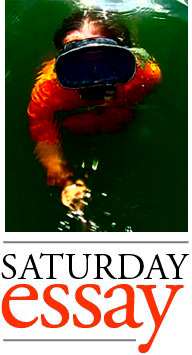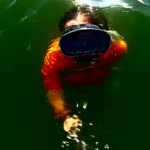Duluth Island
 The discovery of a scale model of Duluth, carved from black coral on a desert island in the South Pacific, sent shockwaves through the scientific community. The miniature cityscape lay in a hand-excavated chamber under the sand, on an uninhabited, unnamed island only half the size of a city block. The flat, round expanse of sand, if noticed at all by distant ships, seems featureless. At twenty feet above sea level, it fully submerges in some storm surges, and might not survive climate change’s rising seas. First appearing on maps in 1941 with a numerical designation, it was not explored until 2015. That’s when a team of American biologists, following a tagged sea turtle, navigated a black reef and set foot on what is now known as Duluth Island.
The discovery of a scale model of Duluth, carved from black coral on a desert island in the South Pacific, sent shockwaves through the scientific community. The miniature cityscape lay in a hand-excavated chamber under the sand, on an uninhabited, unnamed island only half the size of a city block. The flat, round expanse of sand, if noticed at all by distant ships, seems featureless. At twenty feet above sea level, it fully submerges in some storm surges, and might not survive climate change’s rising seas. First appearing on maps in 1941 with a numerical designation, it was not explored until 2015. That’s when a team of American biologists, following a tagged sea turtle, navigated a black reef and set foot on what is now known as Duluth Island.
Sea turtles and sea birds liked the island well enough. It had no trees or flora visible from off its tiny shores, but up close it was seen to support beach grass and some shrubs. The thought of human habitation was so impossible it didn’t cross anyone’s mind until one of the team noticed a square slab of black coral in the island’s dead center. It measured thirty inches by thirty inches and was at least a few inches thick, set into the sand. It was either subsuming into the sand or emerging from it. The object, obviously the product of human labor, remained unexplained as the biologists departed.
A couple of years later a ship of international archeologists arrived to investigate. They determined the slab was a door capping a hollow space. When moved out of place, the secret of the island was revealed. A four-foot-deep shaft in the sand, reinforced with coral blocks, led to a crawlspace with a firepit. There they found driftwood, fish bones, butchered turtle and bird remains, and a sleeping pad of feathers and woven beachgrass. Someone had lived here for at least ten years.
The crawlspace opened into a sunken chamber like a large crypt, lined with worked coral.
The City in the Chamber
At one end of this lemurian sepulcher a twenty-foot well was discovered. The other end of the chamber was nearly out of reach of the ambient light from the crawlspace’s open shaft. It remained a volume of shadow until their eyes focused at the right depth within it, revealing the shape of a model city like an optical illusion, barely distinguishable from the coral of the floor and the walls. But there stood the sloping topography of a hillside on a shoreline, streets and buildings. The porous texture of the reef rock lent the city an alien appearance. The scientists uneasily joked it was the fabled R’lyeh, the sunken monster city of Lovecraft that human sanity failed to survive first contact with.
Then the archeologists recognized the westernmost tip of Lake Superior among the model’s contours. Further research showed it was a perfect replica of Duluth, Minnesota — as the city looked circa 1912. They identified the shoreline, the Aerial Ferry Bridge, the Boat Club, Railroad Street and the warehouse district.
The coral had been worked with metal tools. A hypothesis shaped up: around a century ago, a Duluthian was stranded here for at least a decade. And if this stranding occurred from a previously unknown shipwreck, that meant such a wreck might still lurk offshore.
The archeologists would attempt to find this ship, and then reconstruct its route in reverse until they found a name.
The Impossible Ship
Once they started looking for it, the shallow ruin of a wooden shipwreck was discovered among the folds and crags of the reef. Planks, beams, and metal fixtures had been scattered, smashed, and degraded. But half of it was still half-identifiable as a small ship: a single-masted sloop. The expedition rode high on this discovery, toasting to the quick resolution of the mysteries.
Colloquially they referred to it as the Duluth Island wreck, although the island was still officially nameless. But the incongruous shipwreck resisted identification. It had an anomalous mix of archaic features: although the design seemed modern, the iron fasteners and wooden dowels in the hull planks were anachronistic by about 300 years.
Further, one of the archeologists argued the Duluth Island wreck must have been built in a minimum of two different shipyards: a Dutch one and a French one, based on nails and discernable features of the woodworking. But how did a 1915 Duluthian sail and wreck an impossible ship from the 1700s?
The team grew uneasy. The early joking about the Lovecraftian city reasserted itself in a suppressed shiver. Each of these trained scientists entertained the idea of time-travel despite themselves.
Finally came the discovery of a brass name board identifying the vessel as the French ship L’Utile. The find infused the team with a brief sense of discovery, but problems multiplied: The L’Utile had sunk in 1761. It was a frigate not a sloop. And it had sunk on another desert island altogether — Providence Island — an Australian island 1,000 miles away in a different ocean.
The archeologist who said the Duluth Island wreck was built in two different countries convinced the team: the nameboard accounted for the French features, but the Dutch features still demanded explanation. Tracing backward from Duluth Island, that explanation would have to be sought at the slightly larger Providence.
Now the team was getting nervous. Even the most hard-headed scientist among them dreamed about dimensional rifts as a plausible explanation.
Shipwrecks of Providence
The Duluth Island team got ahold of the Providence Island L’Utile shipwreck team, and spoke with the Australian scientist in charge. They told him they’d found the nameboard of the L’Utile at Duluth Island, mixed in with the wreckage of a hybrid French-Dutch ship from the 1700s, and associated with a shipwrecked Duluthian from 100 years ago. The Duluth Island team got embarrassed explaining it because it sounded so weird, but when the Providence Island guy heard the facts, his face lit up onscreen with a flash of understanding. Because the Providence team had been wrestling with anomalies too, and now he realized how to solve them: the wreck of the L’Utile was a shipwreck on top of another shipwreck.
A Dutch candidate ship emerged: the Zeewijk, a merchant ship that disappeared in the region in 1727.
So apparently, a Duluthian had come to Providence Island 150 years after the L’Utile sank on top of the wreck of the Zeewijk. Maybe this Duluthian fell overboard some passing ship, and swam or drifted to Providence? Or maybe he was abandoned at Providence for mutiny? Or maybe he shipwrecked? If the Duluthian shipwrecked at Providence, that hypothetical wreck added a third, unfound, wreck to the hungry reef’s total. Once marooned there, the Duluthian made a ship out of the compound French and Dutch wrecks. And that is the ship he escaped Providence on, only to wreck at Duluth Island.
Any undiscovered Providence shipwreck was likely in deep water on the slopes of the seamount instead of the lagoon. Subsequently, a shipwreck was found in 300 feet of water. It was the Argentine steamer Holywell Bay, missing since 1917.
The Holywell Bay had set sail from the southern tip of Argentina bound for Madagascar. It never arrived. Blown off course, it had apparently sawed itself open on the Providence Island reef, then tried limping away instead of grounding.
This northland survivor of the Holywell Bay disaster must have scavenged tools from the jetsam or otherwise made tools from the wreckage of Providence. He built his hybrid sloop using the international mix of 300-year-old hull planks preserved under silt and sand. Sails of sea turtle leather unfurled from the mast, and he was off, unknowingly headed for his destiny on Duluth Island.
An American Drifter
The Duluth Island team obtained a historical passenger manifest for the fatal voyage of the Holywell Bay. No Duluth connection was found.
But newly released letters from Antarctic explorer Earnest Shackleton showed there had been a Duluthian in southern Argentina in 1917: Shackleton’s assistant cook Jacques Cloquet, descended from the Voyageurs. Cloquet had been rescued from Antarctica with the other members of the Shackleton expedition. But, an American drifter, he had not proceeded back to England with the rest. He disappeared from the historical record.
Now it seems Cloquet may have lived one of the most extraordinary survival tales of the 20th century.
As the theory goes, after parting from Shackleton in Argentina, Cloquet stowed away on the Holywell Bay. When it sank off Providence Island, he was the lone survivor. Discovering the double shipwreck around the lagoon, he built his patchwork Frankenstein sloop. It took him around a decade. Then he sailed it from the Indian Ocean to the Pacific, where he wrecked on the speck of sand and black coral now known as Duluth Island.
His journeys had been a crucible of intensifying isolation. Over the next ten years, he constructed a model of the home he had so willingly left, and now could not get back to.
What Became of Jacques Cloquet?
Like Providence Island, Duluth Island contains no human remains. The working assumption is Cloquet probably died on Duluth Island around 1937 at age 42. The amount of time the chamber appeared inhabited leads to this conclusion. So maybe he was eaten by a shark in the surf. Maybe he was swept away by a rogue wave.
But one possibility is that he conjured yet another vessel, from the ruins of the two shipwrecks which had become a third. The castaway shoved off on a raft made of three shipwrecks, leaving his dark Duluth for good.
Including two years on the ice with Shackleton, this means Cloquet spent at least 22 years consecutively shipwrecked. From age 20 to age 42, he knew lightless Antarctic winters and merciless tropical suns. His resting place is unknown as of this writing. It is because of him that an insignificant, nameless island on the opposite side of the planet is now legally known as Duluth Island.
An index of Jim Richardson’s essays can be found here.
Recommended Links:
Leave a Comment
Only registered members can post a comment , Login / Register Here














No Comments